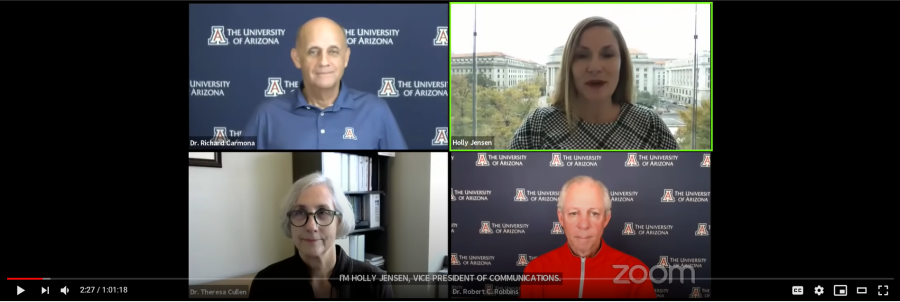The University of Arizona’s COVID-19 reentry task force met Monday morning to discuss the increase in COVID-19 cases in the county and around the country and to elaborate on the university’s pre-holiday testing blitz.
UA President Dr. Robert C. Robbins began the meeting by stating that select courses with up to 50 students will have the option this week of having on-campus instruction, part of Phase 2 of the reentry strategy.
“I’m anticipating we will hopefully, if the public health measures remain, remain in this stage for the next four weeks until the break,” Robbins said.
The rate of transmission for the university’s zip code remains optimal, but transmission across Pima County and throughout the state of Arizona is approaching dangerous levels.
“The Rt for 85719, the zip code surrounding the university, has continued to stay low,” Robbins said, “so thank you for everyone participating and coming together, doing your part to protect society. This past week it was 0.68. Now that’s slightly up from last week, where the value was 0.35. I think our low was 0.16, but still below the magic 1.0 number that we strive for, which is significant. As we’ve discussed previously, we will note that the Rt value for Pima County is now 0.99.”
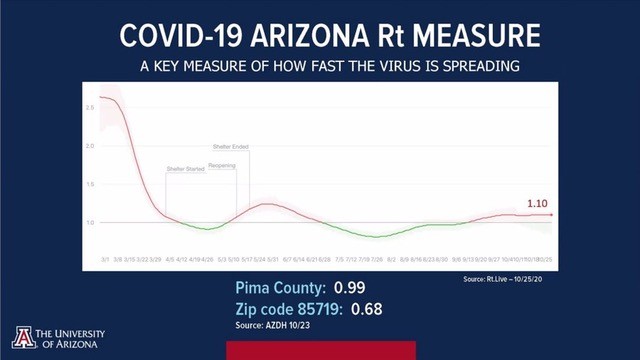
Robbins revisited testing results from the last testing day, Friday, Oct. 23, which only indicated two positive results out of over a thousand tests.
“We also continue to test many students every day. On Friday, Oct. 23, we tested 1,016 tests with only two positives,” Robbins said. “That’s a very very low number, so we’re continuing to test as many people as we possibly can. These numbers aren’t artificially down because we continue to test as many students as we have the capacity to test.”
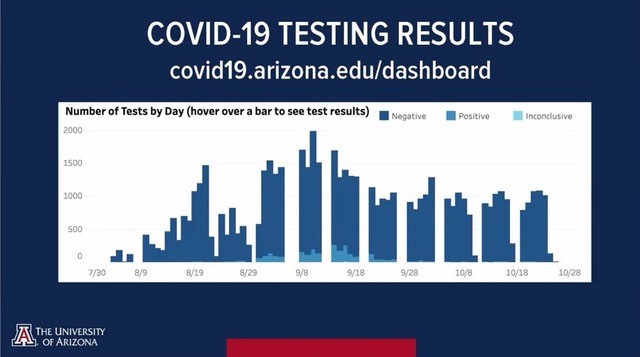
The president also addressed criticism that the university is not taking into account transmission from students residing off-campus, saying that the amount of tests for off-campus students was nearly double that of on-campus students.
“515 off-campus students were tested [on Friday] with only one positive,” Robbins said. “For those who say we’re not testing off-campus students, we’re testing nearly twice as many off-campus as on-campus students.”
Robbins revisited the subject of the Thanksgiving and winter breaks. He strongly urges all students to complete the holiday travel survey and schedule an appointment to get tested before going home for the holidays.
“We’re continuing with our plan for fall break, beginning Nov. 26,” Robbins said. “Students have been sent the required survey asking for their travel plans. This is really important; we need to have them complete this. Upon completion of the survey, they are redirected to a website where they can register for the pre-travel testing blitz.”
Robbins said testing will be by appointment only after Nov. 6, and ideally wants the UA community to test close to the time they plan to travel.
He emphasized the importance of the testing blitz amidst the changing weather and the dawn of influenza season. In addition, Robbins reminded everyone that Halloween masks are not an adequate substitute for COVID-19 mitigation face coverings.
RELATED: Antiviral drug remdesivir becomes first approved treatment for COVID-19
The president expressed optimism about the university’s outlook from now until winter break and urged all members of the Wildcat community to continue to utilize public health precautions to mitigate the transmission of COVID-19.
“I remain optimistic,” Robbins said, “but we have entered a particularly critical period these next four weeks … we’re going into the fourth quarter now to get through this term successfully and we’ve got four weeks to go. From now until Nov. 26, when we expect that many students will leave the Tucson area for the semester break, we need to stay focused, we need to stay vigilant, we need to pay meticulous attention to details. We’re almost there, but we need everybody to do their part please keep it up.”
Taskforce director Dr. Richard Carmona began his segment by displaying a Thanksgiving break to-do list for students, as well as the three travel options available to students pertaining to before and after Thanksgiving break.
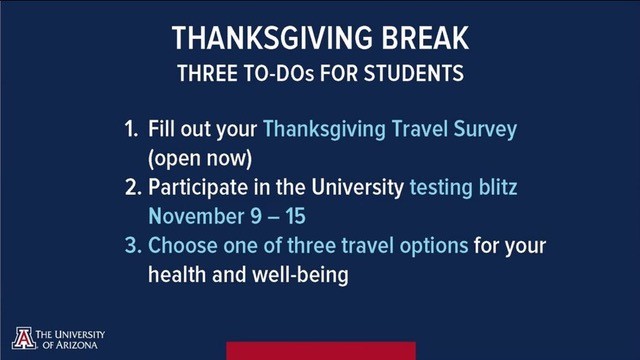
“All of this is based on protecting the campus, protecting the community. As the president said, working with the county and the city to ensure that we are mitigating transmission of disease but yet allowing our students and faculty and all our workers here to be able to enjoy the holiday at a safe distance with a mask and being cognizant of how to decrease transmission,” Carmona said.
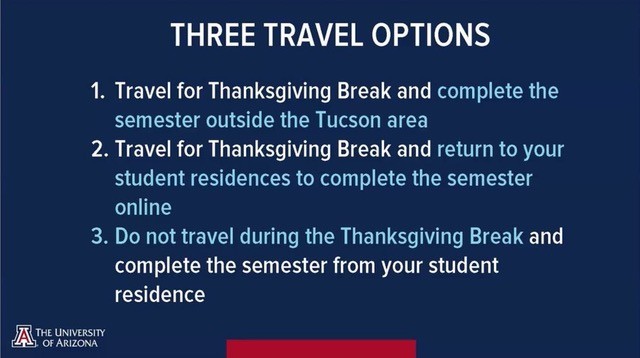
He also noted that whenever a student tests positive, they must isolate for 10 days. All students who test negative are still asked to follow a stay-at-home protocol and refrain from socializing.
“Once we know that you are free of disease, we want to make sure you stay that way,” Carmona said.
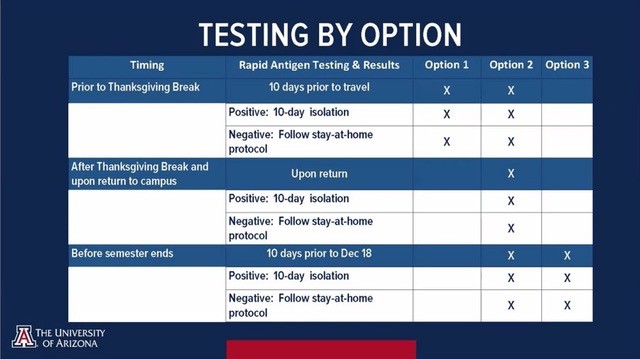
Overall, Carmona said the current state of low cases in the university area was positive, but acknowledged that an increase in resource utilization and an increase in transmission in Pima could spell trouble for the university in the near future.
“Deaths are down, mortality is less, that’s a very good thing,” Carmona said, “but we have more hospitalized patients at the state level. That’s important because you’ve heard us for months talking about surge capacity, bed and ventilator availability and staffing should there be another surge in cases. We are also anticipating flu season starting snowbirds coming in, and we know every year there’s a bump in beds and the need for more medical care.”
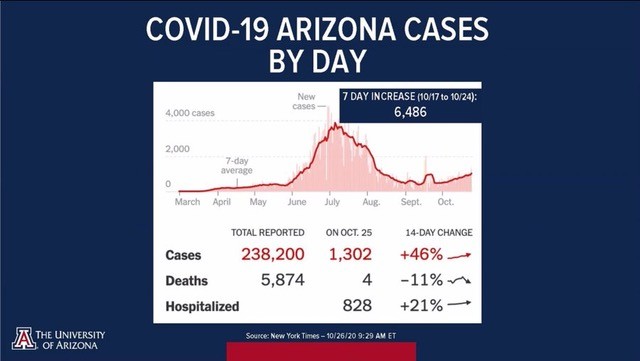
Last week, university CARTs were deployed a total of 12 times, one of which was to a social gathering of over 100 students.
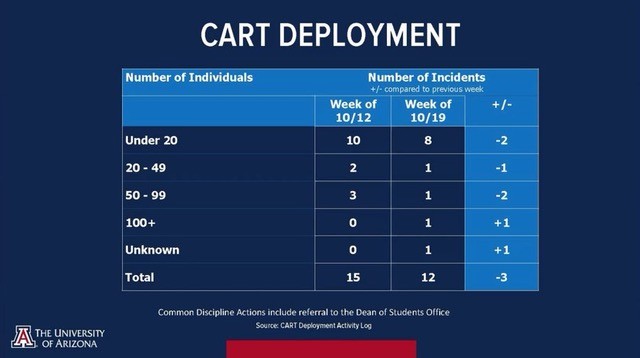
“As you can see, we have gone down consistently, but you see that bump on the right?” Carmona said. “That puts us up around 120 something, I think 128 cases now. It’s still relatively low for a county our size, but still unacceptable. I know Dr. [Theresa Cullen] and I and the public health team here, we want to see that down to nothing and the only way we can do that is to continue to inspire, to cajole, to convince people that this is not a game, this is a deadly disease and there are things we can do, as the president said, using our most accessible tools, a mask, hand washing and social distancing.”
RELATED: Q&A with Nathan Esquerra, UA’s first senior VP for Native American Advancement and Tribal Engagement
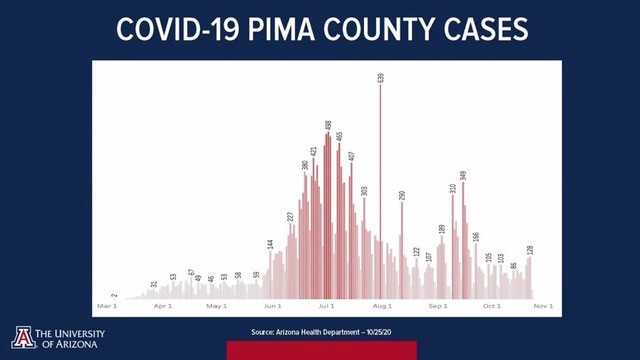
During the Q&A portion of the briefing, the Daily Wildcat asked Robbins if he thought that the continuation of the Live Online course modality for the spring semester would deter students from returning to campus.
“Let’s say we have an effective and safe vaccine and that gets administered throughout the world and we can return back to the way it was before,” Robbins replied. “That would be stage four. Obviously, that’s not going to be applicable to the spring semester, and I’m predicting, I hope I’m wrong about this, but I’m predicting that we’ll be in the same situation next fall. I don’t see even a remote possibility of getting back to stage four before the spring term of 2022 and I would be surprised if we did then. I think, based on how the next month goes, it’ll inform us of how we start back in January.”
The next task force reentry briefing will take place Monday, Nov. 2.
Follow Kristijan Barnjak on Twitter



